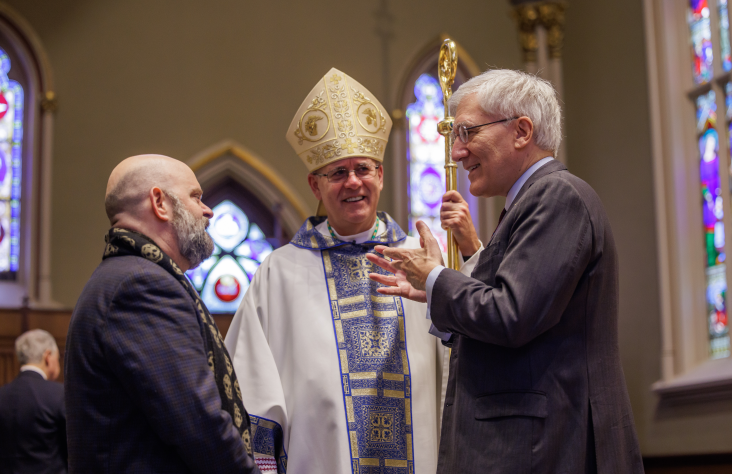April 5, 2017 // Perspective
‘The Look’: men, sin and mission?
A kid can live and die by the look on his mom’s face! Her smile can light up his day, while her disappointment or anger can be a dark cloud. Boys certainly live and die by their dads’ look, too. This is part of God’s design, the communion of persons. While women tend to do better at facial recognition (I have to ask my wife during a movie if that is the same actor/actress), I think most men can at least tell when their women are mad. The face is our most powerful medium of communication. Even Scripture knows this: Moses blesses the people, saying, “The Lord let his face shine upon you!” (Num 6:24-26). On the negative side, David says, “Do not hide your face from me” (Ps 27:9; See also Mic 3:4; Is 8:17; Ps 88:15; 69:18).
The prime of the faith
We are first loved by God, and then challenged to live out that love (1 Jn. 4:19-20). Love and challenge as a prime of our faith is the framework I will use to illustrate what I call “The Look” verse from Luke’s passion (22:61).
When was “The Look”? The
context is Holy Thursday night.
After Jesus celebrates the Passover, he goes through the agony in the Garden of Gethsemane, where he sweats drops of blood as he prays. He is betrayed, arrested and taken to the high priest’s courtyard in the middle of the night, where Peter denies Him. Just as Peter finishes his third denial, the cock crows, “and the Lord turned and looked at Peter.” Peter remembers Jesus’ prediction and weeps bitterly!
It is the timing of the Lord’s turning and looking at Peter that fascinates me. It is right after Peter’s denial — he is in his sin, having just betrayed Jesus. Whenever we sin, we deny and betray Him. But the God of the universe does not wait for us to return; instead, He initiates and turns toward us! How often do we reverse who initiates our reconnection after sin?
What was “The Look”? This turning could be good news, depending on what the look meant. Was it harsh? Angry? Condemning? Vindictive? The look that could kill? I don’t think so. Jesus was not surprised — He had predicted Peter’s denial (22:34). He had also told Peter that Satan had “demanded” to sift him and all the disciples like wheat (22:31), so he knew Peter would struggle. Therefore, I think His look was one of love!
Confirmation of this comes from the arc of salvation history. After Adam and Eve sin, they do not run to God to confess. Rather, it is God who initiates contact: They hear Him walking in the garden, are afraid and run for the bushes. Then God asks, “Where are you?” Has God lost his kids? No! It is a relational question — “Where is my beloved son?” — not a behavioral one — “What did you do?” It is a verbal look of love.
It is the same with the prodigal son’s father. He looks for his son constantly and is overjoyed when he comes home. The question of “Where are you, my beloved son?” has been answered: He is home! Sin is not really ignored here, just overwhelmed with communion/love. Paul puts an exclamation point on things with, “There is no condemnation in Christ.” (Rom. 8:1). His look is one of love, not condemnation.
Why “The Look”? Because love is a powerful force. We need to experience being loved, even in our sins. When we experience “the tender mercy of our God” (Lk 1:78) and not harshness, especially in confession, then we can be driven with Peter to “weep bitterly” over our sins out of gratitude, not necessarily guilt.
And that’s not all: The look of love comes with a challenge, too. Jesus’ look is saying to Peter, “I am not done with you yet.” After Jesus tells him that Satan demands to sift him, He continues, “but I have prayed that your own faith may not fail; and once you have turned back, you must strengthen your brothers” (Lk 22:31-32). Out of Peter’s sin comes his mission. He denies Christ, then spends the rest of his life, through prisons, beatings and ultimately crucifixion (upside down), proclaiming Him and strengthening the brothers. In the look of love, our sins can be turned into our mission. This is a basic principle of Scripture and of 12-step programs: Use your wounds and your forgiven sins to help and love others more (Step 12; Lk 7:47; 2 Cor 1:3-7).
‘The Look’: love and challenge
When you sin, can you experience Jesus turning toward you with the look of love? Going to confession can help. The look of love asks, “Where is my beloved son?” and expresses the Father’s deepest desire for you — He wants you home! Then, “once you have turned back, you must strengthen your brothers.” You have been loved, and now challenged: What is your mission that comes from your wound or sin?
Dave McClow, M.Div. is a counselor with the Pastoral Solutions Institute Tele-Counseling Services. Read more at CatholicExchange.com.
The best news. Delivered to your inbox.
Subscribe to our mailing list today.





